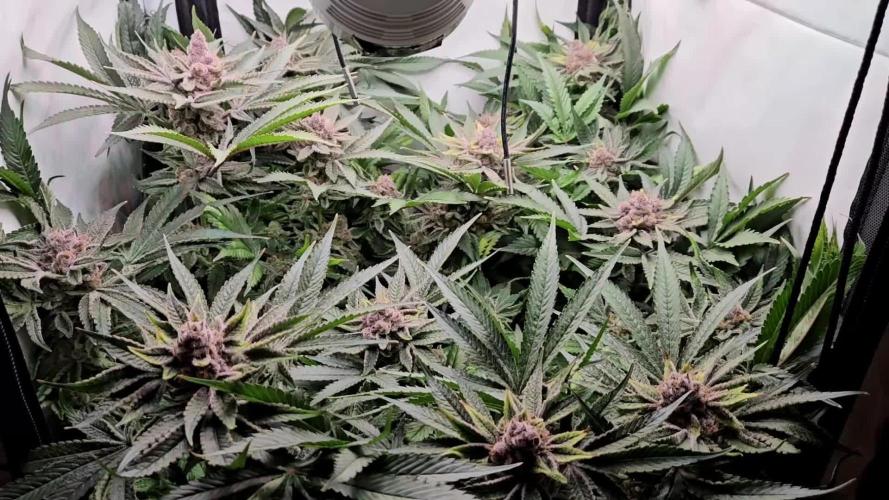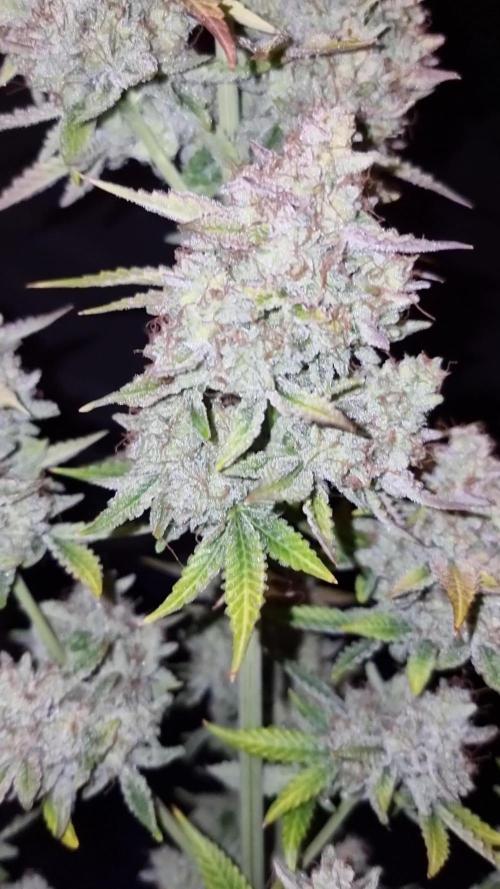The Grow Awards 2026 🏆 





























Likes
3
Share


@stolen_cheese
Follow
Leicht den Überblick verloren. Wurde krank, dann viel Arbeit und keine Zeit gehabt. Die Pflanze hatte zwischendurch mal Probleme, weil ich ihr viel zu viel Wasser gegeben habe und das hat sie locker eine Woche gekostet. Egal, jetzt sieht sie fit aus und geht in die Blüte.
Sie hat 1x 100 ml FertiPlus 5-1-5+ bekommen und eine hohe Dosis Pflanzengeflüster, das hat sie wieder auf Kurs gebracht.
Trainiert wurde nur durch gezieltes Entlauben einzelner Sonnensegel und mit LST Clips
Tag 34: Insgesamt sieht die Pflanze wieder super aus, vielleicht etwas klein fürs Alter. Heute wurde auch stark trainiert.
Likes
12
Share


@AlpenZilla
Follow
🗓️ Week 13 complete – 9th week of flowering (final stage & flush)
🌿 General:
We’re in the final stretch – all three plants are currently being flushed with Flawless Finish.
The fade-out is clearly visible, trichomes are mostly milky with the first hints of amber.
pH remains steady at 6.2–6.3, and drain EC is slowly dropping as the plants break down their internal reserves.
🔴 Seriotica:
Flush is going very smoothly – drain EC has dropped from 2.2 to 1.8.
She’s responding evenly to the Flawless Finish flush (EC ~0.5).
Buds are compact, heavily frosted, and trichomes are hitting the perfect milky stage –
optimal harvest window is just around the corner ❄️🌕
Everything is on track – harvest coming soon!
Likes
21
Share


@KrautFabrik
Follow
Day 66: flush 💦
Pictures are taken on day 70📸
--------------------------------------------------
She is doing good, i will chop her next weekend.
Happy growing 🌱
Likes
43
Share


@Jack_Greenstalk
Follow
end of week 4 I have finished heavy defoliations, now just plucking one or two loose fans here and there. Stretch has totally stopped (finally whew!) and stacking has really begun on the colas. lots of new pistils at bud sights, very few but early signs of some orange pistils, but majority still all white. the smell has gotten outrageous. Nemo smells literally like a blueberry patch! after I defoliate her my hands smell like i was smashing blueberries all day long! V has a more distinct lemon scent, with undertones of mint, basil and spicey peppers. Occasionally the mix smells like a gasey pinesol, but I'm not sure which one the petrol smell is coming from, I'm guessing V, she's a unique boquet for sure!
I am not sure if it is heavy 16 full line, or because I have been religious about getting lots of compost tea feeds, but I've NEVER had a run smell so strong, and so distinct this early! I'm stoked to watch these buds fatten up!
Likes
70
Share


@Tazard
Follow
Week 8 trimmed her pretty good to open her up. I spread branches to maximize their exposure to the hps. She has responded very well. The light burns seem to all be on the fans so they are doing their job and cooling off her flowers. Thanks again for looking!
Likes
40
Share


@Chronicbastard
Follow
Ok these girls are finishing up and I have been using clean water for a little over a week now I'm using flawless finish for the last 7 days.i have one girl that is definetly done but I'm letting her flush a little longer to make sure I have a clean smoke.i did use water and fish shit for a couple waterings but I don't think that will affect anything with taste.if anything I hope it makes it better.my last harvest is still kinda harsh and more of a black ash still.i started using my burp jars today so hopefully that will help.i just over did it with nutrients.even though they are organic they still need a good flush.im going back to advanced nutrients to see if that helps
Likes
31
Share


@BruWeed
Follow
☘️18/07 - Día 113 en Etapa de Floración.
☘️En unos días ya voy a poder podarla y subiré más fotos de como va su evolución.
☘️Por el momento se aprecia que el cogoyo Principal de toda la planta está perfecta, su olor es muy fuerte con toques cítricos y muy resinosa.
☘️Es su segunda semana con TOP WASH de Top Crop en lavado de raíz.
☘️Cada día que pasa se va poniendo más amarillas las hojas.
☘️De apocó van apareciendo reflejos o partes violetas en la planta, en las imagenes se pueden apreciar.
☘️ El día 23/07 deje de darle agua para ya poder cortarla el día 25/07, lleva ya 2 semanas en lavado de raíz.
Likes
11
Share


@Ninjabuds
Follow
The Blackberry Moon Rocks are looking promising. One of them is growing into this beautiful little bush, and I think it's almost ready to harvest. The other plant is stacking up buds, but I'm thinking it's still a couple of weeks away.
The past few weeks have been so beautiful, watching the plants grow and change. It's amazing how something so small and fragile can turn into something so strong and vibrant. Now that they're getting ready to bloom, it feels a little bittersweet. I'm so excited to see the finished product, but I'll definitely miss having them around while they're growing.
Likes
18
Share


@blazin_skywalker
Follow
Growing some seeds I won from Diary of the Month here on Grow Diaries!!! I'm so grateful and excited for another learning experience doing what I love! Thank you, FastBuds! 🙏
Seed was germinated directly in Rapid Rooter placed in a seedling tray. I put her in darkness for 48 hours and then in a sunny window.
Three days later, the seedling's little head poked up and the next day she showed me her first true leaves - calling this day 1.
I kept the seedling tray in a sunny window and brought her outside for lunch on my sunny deck with me for the rest of the week.
Given the heatwave we were having here, I got her settled into her net basket sooner rather than later so that she could have a more stable environment.
This plant will is being grown indoors in an 2x4x8 Gorilla Grow Tent using an 8 gallon Current Culture Solo Bucket under California Lightworks 550 Solar System LED.
For grow media I am using clay pellets and I use the entire Cultured Solutions line of nutrients.
I will be showcasing this plant in a grow tutorial over on my YouTube channel and IGTV where I am going to show a detailed walk through of how I grew my original "Budzilla" plant. Unfortunately, I don't have a grow diary for her, but she is featured on my IG account.
The technique I use I created after harvesting my first grow. I had used low stress training on an autoflower and achieved beautiful results. I took notes the entire grow and conducted a postmortem.
I sincerely advise doing this for EVERY grow - especially when you are learning. It provides you opportunity to figure out what went right, what went wrong, what could have gone better, and what ideas you think you can toss into the mix to try to improve on the places that need revamping.
I did this and I came up with the hypothesis of starting my plant off-center in the net basket, and then growing it low and in a spiral around the outside. In my head, I thought something like this could really push the limits of low stress training, especially when used on an autoflower where we have a limited time of vegetative growth.
I didn't realize, at the time, JUST how effective the technique would be, but when the grower community on IG exploded over the sight of my plant, I started to get a feeling a did something right.
As I was still only growing my second plant in my entire grow career, I was completely oblivious to the fact that I had pushed the normal boundaries of an autoflower.... I had nothing else to really compare it to.
Nearly a year later, photos of my Budzilla are still being shared around social media in the grow community and I still get asked regularly about how I grew her.
And with that, we start here on the journey to attempt the recreation of my former masterpiece. But I'm taking it one step further and giving you a detailed, step-by-step guide so that even the newest of growers can follow along and learn how to push an autoflower to its beautiful edge. Plus.... It's really freaking cool to bonsai a plant 😎.
Anyway, please feel free to subscribe to my YouTube channel! The link is in my bio! I am updating as I go along!
Thanks for growing with me! ✌️💜🌱🙏
Processing
Likes
31
Share


@NorCal311
Follow
10/29/19 - All is going good. The stretch always amazes me on how fast they grow! Watering 4 cups of water each plant every three days. I did not switch to 13/11 yet. I will do that the last few weeks. I moved the lights up to compensate for the stretch so lets see what that does.
10/31/19 - Moved the one that is not flourishing from the net to the side. The other are rocking the house!!! Did a bunch or rearranging and LST in the net. Should be set this week to leave it all alone. I also did a bunch of defoliation. Too bad I was not going to clone this strain anymore, cause there was some great cuttings. 👌
Likes
15
Share


@Solarcradle
Follow
Dec 12 @1am: Her light schedule was been bumped down to 14 hrs. I have a photoperiod in the tent that needs a few days for harvest. Haze is now under the 1000W Phlizon/245W power draw lighting.
Dec 12 @2:30am: New pot has been amended with approximately 65% fresh coco coir, about 20% worm castings,15% perlite and 17 tablespoons/51 teaspoons (12.75 teaspoons per gallon) in a 4 gallon pot. The pot will be thoroughly rinsed to rid salts from the old coco coir used in the pot.
Dec 12 @6pm: Approximately 1" tall
Dec 12: I think my dog got ahold of one of her cotyledons, unless it just disappeared. :)
Dec 14 @2am: Transplanted to the newly amended pot. I watered her and the fresh coco coir mix she was transplanted into.
Dec 14 @11:30pm: Her lighting went from 14 hrs to 24 with both veg and bloom lights on. (Photoperiod in tent harvested)
Likes
38
Share


@MariRemediesLLC
Follow
Since they are autos, I topped them once to give me 4 colas. I’m a 4 cola type of guy for now. Beginner!
Likes
8
Share


@Cdn_Chronic
Follow
Pretty slow week, using about 1 gallon of water for all three every other day, I think are a little behind but they look good !
Likes
49
Share


@Bronhitis
Follow
This is first plant of 4, so total dry weight will be updated in about 2 weeks. I made a quick video about bud development, because i couldnt find it anywhere on the web.
Likes
18
Share


@thenotillwizard
Follow
Harvested at day 76, after 72h of darkness.
Very good yield!
3.3 pounds of dry buds + 1 pound of trim
The 2 keepers yielded 366 and 342g of premium quality smoke.
Very uplifting and energizing high :) Love it!
























